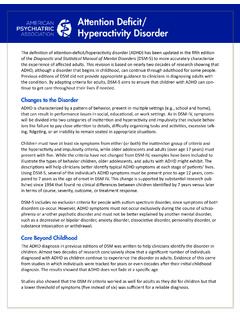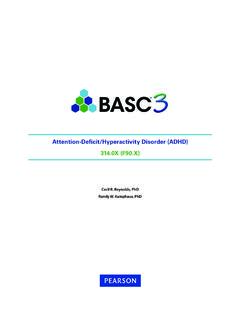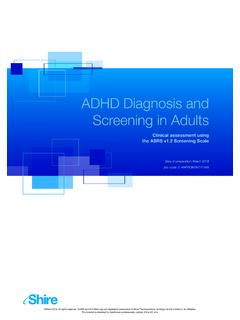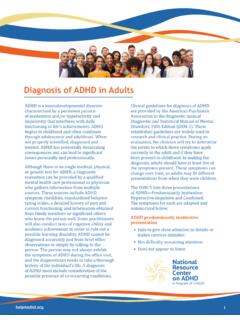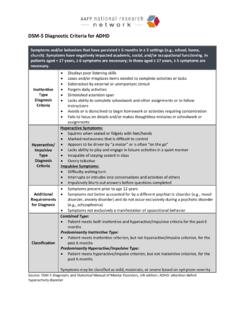Transcription of Vanderbilt ADHD Rating Scales Scoring Instructions
1 Vanderbilt adhd Rating Scales Scoring Instructions Baseline Assessment The validation studies for the Vanderbilt Assessment Scales were for the 6 to 12-year-old age group. However, to the extent that they collect information to establish Diagnostic and Statistical Manual of Mental Disorders, Fifth Edition (DSM-5) criteria and are not based on normative data, they are useful for collecting information in order to make a diagnosis for other age groups, preschoolers, and adolescents. These Scales should not be used alone to make a diagnosis of adhd without confirming and elaborating the information as well as collecting additional information by interviews with at least the primary caregivers (usually parents) and patients. Additional information from teachers and other school personnel is also important to take into consideration information from multiple sources.
2 Scores of 2 or 3 on a single symptom question reflect often-occurring behaviors. Scores of 4 or 5 on performance questions reflect problems in performance. The initial assessment Scales , parent and teacher, have 2 components: symptom assessment and impairment in performance. On both parent and teacher initial Scales , the symptom assessment screens for symptoms that meet criteria for inattentive (items 1 9) and hyperactive (items 10 18) attention-deficit/hyperactivity disorder ( adhd ). Scoring for Diagnostic Purposes To meet DSM-5 criteria for the diagnosis , one must have at least 6 positive responses to the inattentive 9 or hyperactive 9 core symptoms, or both. A positive response is a 2 or 3 (often, very often) (you could draw a line straight down the page and count the positive answers in each sub segment).
3 The initial Scales have symptom screens for 3 other comorbidities: oppositional-defiant disorder, conduct disorder, and anxiety/ depression. (The initial teacher scale also screens for learning disabilities.) These are screened by the number of positive responses in each of the segments. The specific item sets and numbers of positives required for each comorbid symptom screen set are detailed below and on the next page. The second section of the scale has a set of performance measures, scored 1 to 5, with 4 and 5 being somewhat of a problem/ problematic. To meet criteria for adhd there must be at least 2 items of the performance set in which the child scores a 4, or 1 item of the performance set in which the child scores a 5; ie, there must be impairment, not just symptoms, to meet diagnostic criteria.
4 Scoring to Monitor Symptom and Performance Improvement For the purposes of tracking symptoms and symptom severity in order to monitor the effects of treatment, calculate the mean response for each sub segment of the adhd symptom assessment screen items (inattentive 9 and hyperactive 9). To calculate the mean responses, first total the responses (0s, 1s, 2s, and 3s) from each item within the inattentive sub segment (items 1 9) and divide by the number of items that received a response. For example, if a parent only provided responses to 7 of the first 9 items, the responses would be totaled and divided by 7. Follow the same calculation Instructions for the hyperactive sub segment (items 10 18). Parent Assessment Scale Teacher Assessment Scale Predominantly Inattentive subtype Must score a 2 or 3 on 6 out of 9 items on questions 1 9.
5 AND Score a 4 on at least 2, or 5 on at least 1 of the performance questions 1-8. Predominantly Inattentive subtype Must score a 2 or 3 on 6 out of 9 items on questions 1 9. AND Score a 4 on at least 2, or 5 on at least 1 of the performance questions 1-8. Predominantly Hyperactive/Impulsive subtype Must score a 2 or 3 on 6 out of 9 items on questions 10 18. AND Score a 4 on at least 2, or 5 on at least 1 of the performance questions 1-8. Predominantly Hyperactive/Impulsive subtype Must score a 2 or 3 on 6 out of 9 items on questions 10 18. AND Score a 4 on at least 2, or 5 on at least 1 of the performance questions 1-8. adhd Combined Inattention/Hyperactivity Requires the criteria on Inattentive and Hyperactive/Impulsive subtypes adhd Combined Inattention/Hyperactivity Requires the criteria on Inattentive Hyperactive/Impulsive subtypes Oppositional-Defiant Disorder Must score a 2 or 3 on 4 out of 8 behaviors on questions 19 26.
6 AND Score a 4 on at least 2, or 5 on at least 1 of the performance questions 1-8. Oppositional-Defiant/Conduct Disorder Must score a 2 or 3 on 3 out of 10 items on questions 19 28. AND Score a 4 on at least 2, or 5 on at least 1 of the performance questions 1-8. Conduct Disorder Must score a 2 or 3 on 3 out of 14 behaviors on questions 27 41. AND Score a 4 on at least 2, or 5 on at least 1 of the performance questions 1-8. Anxiety/Depression Must score a 2 or 3 on 3 out of 7 behaviors on questions 42 48. AND Score a 4 on at least 2, or 5 on at least 1 of the performance questions 1-8. Anxiety/Depression Must score a 2 or 3 on 3 out of 7 items on questions 29 35.
7 AND Score a 4 on at least 2, or 5 on at least 1 of the performance questions 1-8. Learning Disabilities Must score a 5 on 1 of the performance questions 1-3.
